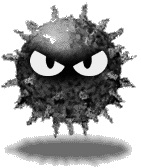“Don’t look at me, I’m a monster!” The herpes simplex virus (HSV) plagues many people worldwide putting them at social and more importantly physical danger as the virus can lead to mortal complications. Researchers of the University of Washington and Hutchinson Cancer Research Center found that Nelfavir can trap herpes within cells and turn it from a danger to an annoyance.
This study looked into the ways in which Nelfinavir (NFV), an anti-cancer drug, could be used to combat the virus causing herpes, specifically HSV-1. HSV is a non-living, infectious agent that looks like a durian fruit. The DNA of the virus is inside while the outside “skin” is made of protein and “spikes” are made of glycoproteins (sugar-proteins). The glycoproteins are what allow the virus to enter human cells and infect. HSV infection causes the cell to waste its resources to make new viruses that can infect other cells. With HSV comes elevated risk of aquiring HIV and Kaposi sarcoma, a cancer.
Imagine a factory that makes cars and all the machinery inside is blue. The factory can be equated to a cell. If a virus infects, this would be akin to someone adding instructions and an extra machine or two to the factory that now allows bombs to be made in the car factory. Imagine the extra machine is yellow. It is easy to spot and get rid of the extra machinery that is making bombs if it does not look like the original factory machinery. This is how most drugs target and destroy viruses. The virus machinery is often easy to differentiate from cell machinery. What if the virus machinery were also blue? This is when a virus becomes drug resistant. The virus has changed, so the drug can no longer target and destroy it. Instead of targeting the virus itself, another method of stopping viruses is by changing the cell machinery so that it will rarely make a fully functioning bomb (virus). This is how NFV acts on HSV-1.
The researchers infected human connective tissue cells, fibroblasts, with HSV-1 and treated with NFV to measure its effectiveness in blocking virus production in vitro. It was found that NFV blocked viral protein maturation, glycoprotein development, and viral packaging.
Virus retention inside the cell was 79:14, NFV treated:untreated
Virus particles found outside the cell was 3:51, NFV treated:untreated
Virus completion inside the cell was 0:9, NFV treated:untreated
This meant that although HSV-1 was getting into the cells, new viruses were created broken and could not leave or infect other cells. It was also found that HSV-1 was not becoming resistant to the drug even after subjected to drug pressure. This is because NFV affects the cell rather than virus.
This newfound use for Nelfinavir shows promise for longterm control of herpes. This ubiquitous and malignant virus may soon be just a small bother.
Reference:
Soren Gantt, Eliora Gachelet, Jacquelyn Carlsson, Serge Barcy, Corey Casper, Michael Lagunoff. Nelfinavir Impairs Glycosylation of Herpes Simplex Virus 1 Envelope Proteins and Blocks Virus Maturation. Advances in Virology, 2015
http://dx.doi.org/10.1155/2015/687162


